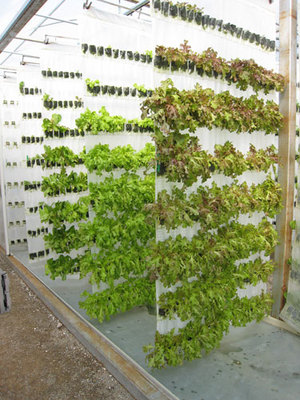
|
| ©Valcent Products Inc |
| Veggies growing on an overhead conveyor system |
Valcent Products Inc. (OTCBB: VCTPF) introduces its revolutionary High Density Vertical Growth (HDVG) system, now producing vegetables within its greenhouse production plant in El Paso, Texas. The HDVG technology provides a solution to rapidly increasing food costs caused by transportation/fuel costs spiraling upwards with the cost of oil. Together with higher cost comes a reduction in availability and nutritional values in the food we consume.
Developed over several years by Valcent's research and development partner, Pagic Inc., the system is designed to grow vegetables and other foods much more efficiently and with greater food value than in agricultural field conditions. The HDVG system demonstrates the following characteristics:
* Produces approximately 20 times the normal production volume for field cropsHow It Works
* Requires 5% of the normal water requirements for field crops
* Can be built on non arable lands and close to major city markets
* Can work in a variety of environments: urban, suburban, countryside, desert etc.
* Does not use herbicides or pesticides
* Will have very significant operating and capital cost savings over field agriculture
* Will drastically reduce transportation costs to market resulting in further savings, higher quality and fresher foods on delivery, and less transportation pollution
* Will be easily scalable from small to very large food production situations
The HDVG system grows plants in closely spaced pockets on clear, vertical panels that are moving on an overhead conveyor system. The system is designed to provide maximum sunlight and precisely correct nutrients to each plant. Ultraviolet light and filter systems exclude the need for herbicides and pesticides. Sophisticated control systems gain optimum growth performance through the correct misting of nutrients, the accurate balancing of PH and the delivery of the correct amount of heat, light and water.
Why Now?
* Reduced Global Transport and Associated Carbon EmissionsHDVG - The Solution
* Food and Fuel Safety, Security and Sovereignty
* Local Food is Better for Public Health
* Building Local Economies
* Control of Externalities and True Costs
In a rapidly urbanizing world where the majority of people now live in cities, localization requires that food and fuel be produced in an urban context. At present, there are no examples of a locally sustained urban community anywhere in the world. Urban sustainability is yet to be realized primarily because urban agriculture presents a number of technological challenges. The main challenge is a lack of growing space.
Vertical growing is a new idea currently emerging in the sustainability discourse which offers great promise for increasing urban production. Vertical growing systems have been proposed as possible solutions for increasing urban food supplies while decreasing the ecological impact of farming. The primary advantage of vertical growing is the high density production it allows using a much reduced physical footprint and fewer resources relative to conventional agriculture.
Vertical growing systems can be applied in combination with existing hydroponic, and greenhouse technologies which already address many aspects of the sustainable urban production challenge (i.e., soil-free, organic production, closed loop systems that maximize water and nutrient efficiencies, etc.). Vertical growing, hydroponics and greenhouse production have yet to be combined into an integrated commercial production system, but, such a system would have major potential for the realization of environmentally sustainable urban food and fuel production.



Comment: Maybe individuals could incorporate some of these ideas in increasing the yields of their own growing efforts.